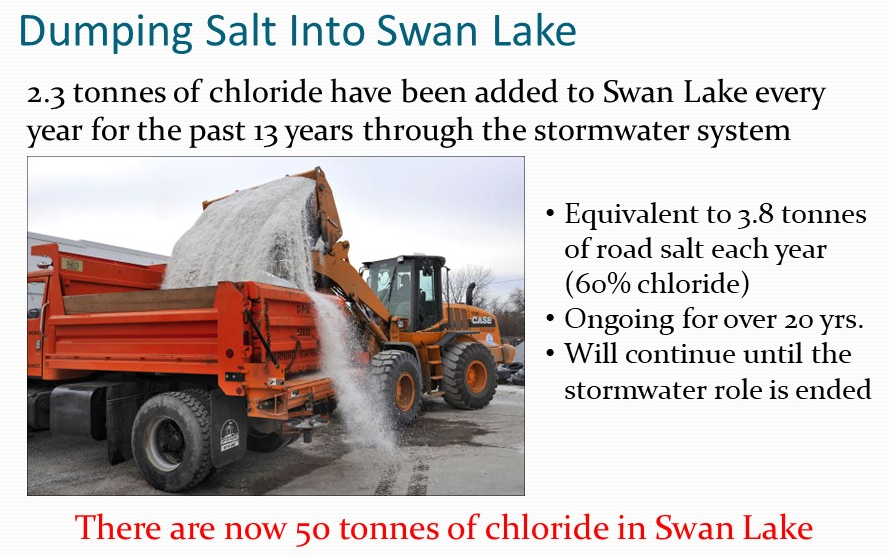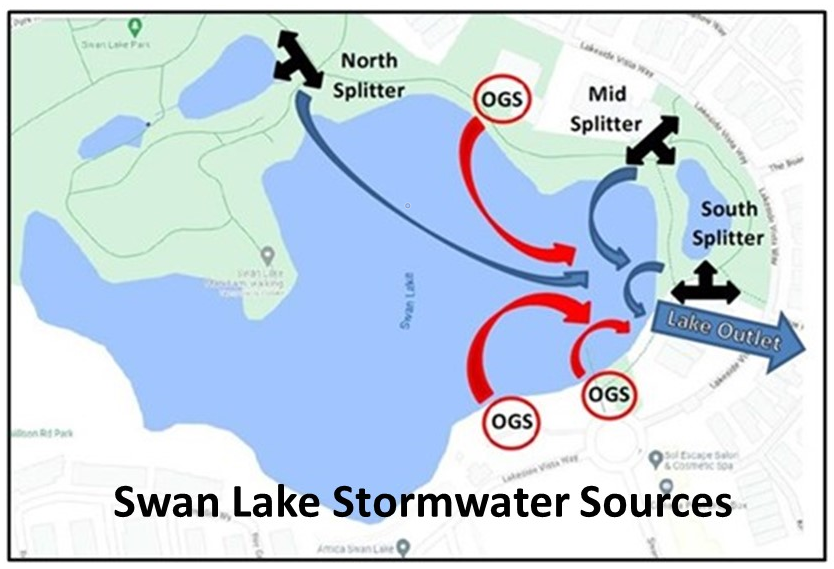Swan Lake Park’s role as a “Natural Spaces/Wildlife Places” community park is undermined by several early design decisions that established Swan Lake as an active element in the local stormwater management regime. In essence, Swan Lake is the “third” stormwater pond in Swan Lake Park, and we believe this role is not necessary and should be minimized.
Water quality in Swan Lake is deteriorating each year. Initiatives are underway to minimize and manage phosphorus and nitrogen levels but the build-up of chloride from road salt that is undermining the aquatic environment.
Swan Lake can no longer be described as a freshwater lake. Due to the chloride, the water is classified as “brackish” and the condition is only going to get worse since there are no obvious ways to remove the chloride and there are no substantive programs in place to reduce the annual build-up of chloride.

Currently, annual stormwater flows, and road salt are unnecessarily being recycled through Swan Lake from six areas.

Enhanced salt management practices must be encouraged but the challenge of addressing excessive chloride levels in Swan Lake lies primarily in minimizing Swan Lake’s role in the local stormwater management regime and establishing a rigorous maintenance routine.
Five-Step Action Program
Given that use of road salt can only be minimized, not discontinued, we recommend Markham adopt a five-step program as soon as possible to reduce the continuing inflow of road salt into Swan Lake:
Action #1: Reroute the three oil/grit separator flows into the main stormwater sewer system.
Action #2: Minimize the stormwater flows bypassing the ponds and entering Swan Lake by redesigning the pond infrastructure.
Action #3: Implement an effective pond monitoring and maintenance program to ensure future stormwater flows are not unnecessarily contaminating Swan Lake.
Action #4: Initiate an educational and awareness program in the local community to minimize use of road salt.
Action #5: Expedite research into approaches for removing chloride already in Swan Lake.
Our analysis identifies three core benefits arising from these proposed changes to the local infrastructure:
- Swan Lake would become a self-contained entity retaining more of the clean local runoff and precipitation. Contaminated stormwater from the local communities would substantially remain in the stormwater system. Simply increasing the blend of fresh water within the lake should help enhance water quality and the aquatic environment.
- Any additional flows directed downstream would be rerouted through the more tightly controlled pond management system rather than the lake outlet system, further minimizing downstream flooding risk.
- Annual chloride contributions would be reduced over 80%. Minimizing the increase in chloride levels will provide an improved aquatic environment for zooplankton and small fish that are a natural means of controlling algae growth, reduce the risk of chloride contamination of the downstream aquifer and reduce future costs of expensive chemical treatments.

